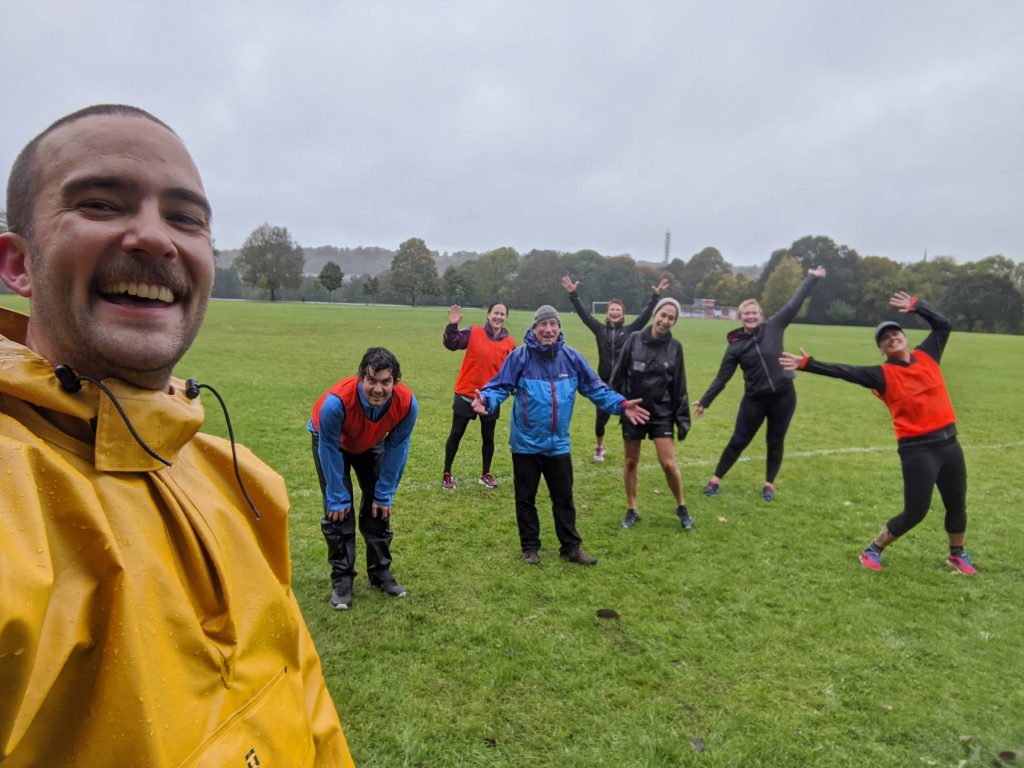On a relentlessly rainy Sunday morning that did its best to put off anyone sensible, it was brilliant to have eight players present for the inaugural World Sports Club. The plan had been to arrive early and find a good spot to set out our lapta pitch but we weren’t exactly struggling for position, being the only people in Eastville Park bar the occasional sodden dog walker.
We assembled under a tree thinking it might provide some shelter, though the leaves instead seemed to just gather the rain into larger droplets and soon we were all soaked through. Still, we were warmed by the joy of seeing each other again at our first in-person class since the lockdown and excited to get started.
The planned warm-up, an Indonesian game called benthik, proved to be more of a cool-down – a fairly stationary activity perhaps better suited to warmer weather. The object of the game is to scoop a short piece of bamboo off two stones using a longer stick. Fielders attempt to catch the short stick and then use it to strike a wicket formed by placing the longer stick across the stones. If the batter is not caught, they measure the distance that they hit the stick, score that number of points, and bat again, but this time with a different technique – the short stick being held vertically between the palm and the stone. On the third round, it is lent against a stone, scooped up and hit out.
We only played two rounds, which perhaps didn’t give us long enough to figure out the optimal batting technique and achieve the distances managed by children on YouTube, but Nic developed a ground-skimming method that thwarted any catching and Lotte managed the elusive third-round scoop-and-whack. But those blossoming bethnik careers were thwarted by the fact that some of us were visibly shivering, so we moved on to something more active – lapta.
Lapta is a Russian bat-and-ball game that has been played since at least the 14th century. Despite the amount of time it’s been around, it was very difficult to find a comprehensive ruleset in English – most of the written information was about how you need “firm eternal confidence that you cannot be defeated” and that “the lazy and cowardly have no place in this game”. Despite this, we marked out a pitch with the mandatory coloured cones and divided into teams wearing the equally mandatory, and very flattering, orange bibs, and started trying to figure out how to play.
Lapta could be described as a sort of mix between rounders, bulldogs and dodgeball. The pitch, which can be anywhere between 20-45m wide and 35-80m long, is divided into two unequal sections – the gorod (city), which measures from the baseline to a boundary (called the salo) drawn 10m down the length of the pitch, and the kon, which extends from the salo to the end of the pitch. Beyond that end-line is the prigorod (the suburbs).
The batting team line up at the baseline and the fielding team disperse themselves in the kon. One member of the batting team throws a ball to the batter, who uses a cricket-like bat to hit the ball beyond the salo without going out of bounds. They have two attempts. When this is managed, the batting team rush up the field and must make it from the city to the safety of the suburbs and possibly back again, avoiding the fielding wildfolk in the kon. If they make it, they score two points each. The fielding team attempt to catch the ball (getting the batter “out”) and then throw the ball at members of the batting team to prevent them from scoring. They can throw to each other and chase members of the batting team to get a better position.
We had half an hour left in the class and, knowing games are usually 30 mins each half, thought we’d take it easy by playing just 15 minutes each way. The batting team soon realised that the “game” was essentially just endless shuttle runs in the rain while being pelted with a muddy tennis ball, so we all agreed to play 7-minute quarters instead.
By the third quarter, some tactics had emerged. Jayde skirted the boundaries on her sprints through the kon, Maria made use of an overhead batting technique to great effect, Sally introduced a paired back-stop hunting strategy to the fielding, and Jen used a self-sacrificing decoy run from the suburbs to get her batting team back to safety.
As the sprints added up, and there were an increasing number of players lingering in the suburbs, there was some debate about whether the entire batting team always had to run. We had a brief discussion and decided that, really, none of us had to do anything.
With that liberating thought, and without any idea of what the score was, I can confidently say that we tied at 50-all (thanks Mike) and so were all winners (or losers, depending on how you look at it – we were soaking wet and knackered).
It was brilliant fun and we hope you can join us for two different sports next Sunday, this time at 16:00.

